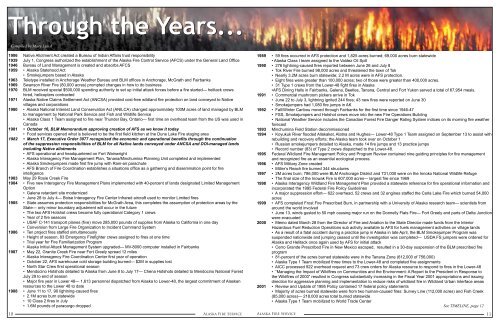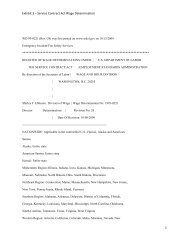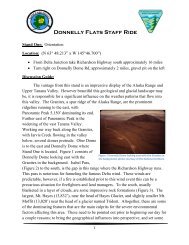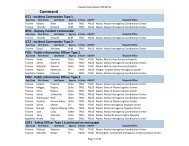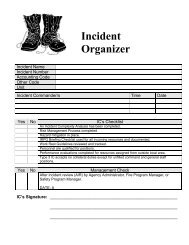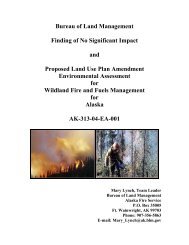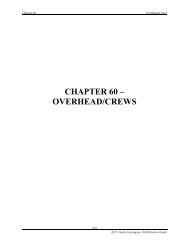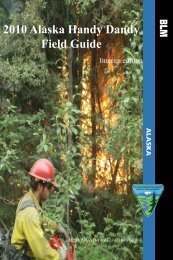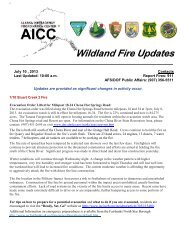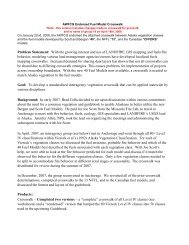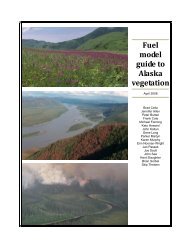Celebrating 25 Years - Alaska Interagency Coordination Center ...
Celebrating 25 Years - Alaska Interagency Coordination Center ...
Celebrating 25 Years - Alaska Interagency Coordination Center ...
Create successful ePaper yourself
Turn your PDF publications into a flip-book with our unique Google optimized e-Paper software.
Through the <strong>Years</strong>...<br />
Compiled by Mary Lynch<br />
1906 native Allotment Act created a Bureau of indian Affairs trust responsibility<br />
1939 July 1, Congress authorized the establishment of the <strong>Alaska</strong> Fire Control Service (AFCS) under the General Land Office<br />
1946 Bureau of land management is created and absorbs AFCS<br />
1959 • <strong>Alaska</strong> Statehood Act<br />
• Smokejumpers based in <strong>Alaska</strong><br />
1963 Teletype installed in Anchorage Weather Bureau and BLM offices in Anchorage, McGrath and Fairbanks<br />
1969 Swanson River Fire (80,000 acres) prompted changes in how to do business<br />
1970 BLM received special $500,000 spending authority to set up initial attack forces before a fire started— helitack crews<br />
hired, helicopters contracted<br />
1971 <strong>Alaska</strong> Native Claims Settlement Act (ANCSA) provided cost-free wildland fire protection on land conveyed to Native<br />
villages and corporations<br />
1980 • <strong>Alaska</strong> National Interest Land Conservation Act (ANILCA) changed approximately 100M acres of land managed by BLM<br />
to management by national Park Service and Fish and Wildlife Service<br />
• <strong>Alaska</strong> Class 1 Team assigned to fire near Thunder Bay, Ontario— first time an overhead team from the US was used in<br />
Canada<br />
1981 • October 16, BLM Memorandum approving creation of AFS as we know it today<br />
• Food services opened what is believed to be the first field kitchen at the Dune Lake Fire staging area<br />
1982 • March 17, Executive Order 3077 recognized the economic and operational benefits through the continuation<br />
of the suppression responsibilities of BLM for all Native lands conveyed under ANCSA and DOI-managed lands<br />
including Native allotments<br />
• AFS operational and headquartered on Fort Wainwright<br />
• <strong>Alaska</strong> interagency Fire management Plan, tanana/minchumina Planning Unit completed and implemented<br />
• <strong>Alaska</strong> Smokejumpers made first fire jump with Ram-air parachute<br />
• AFS Branch of Fire <strong>Coordination</strong> establishes a situations office as a gathering and dissemination point for fire<br />
intelligence<br />
1983 may 29 Rosie Creek Fire<br />
1984 • Five new interagency Fire management Plans implemented with 40-percent of lands designated limited management<br />
Option<br />
• Galena retardant site modernized<br />
• June 28 to July 4— Boise <strong>Interagency</strong> Fire <strong>Center</strong> Infrared aircraft used to monitor Limited fires<br />
1985 • State assumes protection responsibilities for mcGrath Area, this completes the assumption of protection areas by the<br />
State— only minor boundary adjustment will occur in the future<br />
• the two AFS hotshot crews become fully operational Category 1 crews<br />
• Year of 2 fire seasons<br />
• USAF C-141 transport planes (five) move 285,000 pounds of supplies from <strong>Alaska</strong> to California in one day<br />
• Conversion from large Fire Organization to incident Command System<br />
1986 • Ten project fires staffed simultaneously<br />
• Height of season, 83 Emergency Firefighter crews assigned to fires at one time<br />
• trial year for Fire Familiarization Program<br />
• <strong>Alaska</strong> Initial Attack Management System upgraded— MV-8000 computer installed in Fairbanks<br />
1987 • may 22, Granite Creek Fire near Fort Greely spread 12 miles<br />
• <strong>Alaska</strong> <strong>Interagency</strong> Fire <strong>Coordination</strong> <strong>Center</strong> first year of operation<br />
• October 22, AFS warehouse cold storage building burned— $2m in supplies lost<br />
• North Star Crew first operational season<br />
• mendocino hotshots detailed to <strong>Alaska</strong> from June 8 to July 17— Chena hotshots detailed to mendocino national Forest<br />
July 29 to end of season<br />
• Major fire year in Lower 48— 1,613 personnel dispatched from <strong>Alaska</strong> to Lower-48, the largest commitment of <strong>Alaska</strong>n<br />
resources to the lower 48 to date<br />
1988 • June 11 to 17, 90 lightning-caused fires<br />
• 2.1m acres burn statewide<br />
• 10 Class 2 fires in July<br />
• 1.6m pounds of paracargo dropped<br />
10<br />
<strong>Alaska</strong> Fire Service<br />
1989 • 59 fires occurred in AFS protection and 1,8<strong>25</strong> acres burned; 69,000 acres burn statewide<br />
• <strong>Alaska</strong> Class I team assigned to the Valdez Oil Spill<br />
1990 • 276 lightning-caused fires reported between June 26 and July 8<br />
• tok River Fire burned 98,000 acres and threatened the town of tok<br />
• nearly 3.2m acres burn statewide; 2.2 m acres were in AFS protection.<br />
• Eight fires were greater than 100,000 acres; two of those were greater than 400,000 acres.<br />
• 31 Type 1 crews from the Lower-48 fight fires in <strong>Alaska</strong><br />
•AFS dining halls in Fairbanks, Galena, Beetles, tanana, Central and Fort Yukon served a total of 67,954 meals.<br />
1991 • Commercial mushroom pickers arrive in tok<br />
• June 22 to July 3, lightning ignited 244 fires; 43 new fires were reported on June 30<br />
• Smokejumpers had 1,080 fire jumps in AK<br />
1992 • Fall/Winter Caribou moved through Fairbanks for the first time since 1946-47<br />
• FSS, Smokejumpers and hotshot crews move into the new Fire Operations Building<br />
• National Weather Service includes the Canadian Forest Fire Danger Rating System indices on its morning fire weather<br />
forecast<br />
1993 minchumina Field Station decommissioned<br />
1994 • Koyukuk River flooded Allakaket, Alatna and Hughes— Lower-48 Type 1 Team assigned on September 13 to assist with<br />
rebuilding and recovery efforts; the <strong>Alaska</strong> team took over on October 1<br />
• Russian smokejumpers detailed to <strong>Alaska</strong>, made 14 fire jumps and 13 practice jumps<br />
• Record number (83) of Type 2 crews dispatched to the Lower-48.<br />
1995 Federal Wildland Fire Management Policy and Program Review contained nine guiding principles for fire management<br />
and recognized fire as an essential ecological process.<br />
1996 • AFS military Zone created<br />
• Miller’s Reach fire burned 344 structures<br />
1997 • 2m acres burn; 786,000 were Blm Anchorage district and 731,000 were on the innoko national Wildlife Refuge<br />
• The final size of the Inowak Fire is 607,000 acres— largest fire since 1969<br />
1998 • <strong>Alaska</strong> <strong>Interagency</strong> Wildland Fire Management Plan provided a statewide reference for fire operational information and<br />
incorporated the 1995 Federal Fire Policy Guidelines<br />
• A major suppression effort— 622 overhead, 52 crews and 32 engines staffed the Carla lake Fire which burned 54,000<br />
acres<br />
1999 • AFS completed Frost Fire Prescribed Burn, in partnership with a University of <strong>Alaska</strong> research team— scientists from<br />
around the world involved<br />
• June 13, winds gusted to 50 mph causing major run on the donnelly Flats Fire— Fort Greely and parts of delta Junction<br />
were evacuated<br />
2000 • memo dated march 28 from the director of Fire and Aviation to the State director made funds from the interior<br />
hazardous Fuel Reduction Operations sub activity available to AFS for fuels management activities on village lands<br />
• As a result of a fatal accident during a practice jump in <strong>Alaska</strong> in late April, the Blm Smokejumper Program was<br />
suspended nationwide and jumping ceased until the investigation was completed— USdA FS jumpers were ordered for<br />
<strong>Alaska</strong> and helitack once again used by AFS for initial attack<br />
• Cerro Grande Prescribed Fire in New Mexico escaped, resulted in a 30-day suspension of the BLM prescribed fire<br />
program<br />
• 81-percent of the acres burned statewide were in the Tanana Zone (612,000 of 756,000)<br />
• <strong>Alaska</strong> Type 1 Team mobilized three times to the Lower-48 and completed five assignments<br />
• AICC processed 922 overhead request and 73 crew orders for <strong>Alaska</strong> resource to respond to fires in the Lower-48<br />
• “Managing the Impact of Wildfires on Communities and the Environment: A Report to the President in Response to<br />
the Wildfires of 2000” resulted in Congress substantially increasing in the Fiscal Year 2001 appropriations and issuing<br />
direction for aggressive planning and implementation to reduce risks of wildland fire in Wildland Urban Interface areas<br />
2001 • Review and Update of 1995 Policy contained 17 federal policy statements<br />
• Majority of acres burned statewide were from two human-caused fires: Survey Line (112,000 acres) and Fish Creek<br />
(85,000 acres)— 218,000 acres total burned statewide<br />
• <strong>Alaska</strong> type 1 team mobilized to World trade <strong>Center</strong><br />
See TIMELINE, page 12<br />
<strong>Alaska</strong> Fire Service 11


